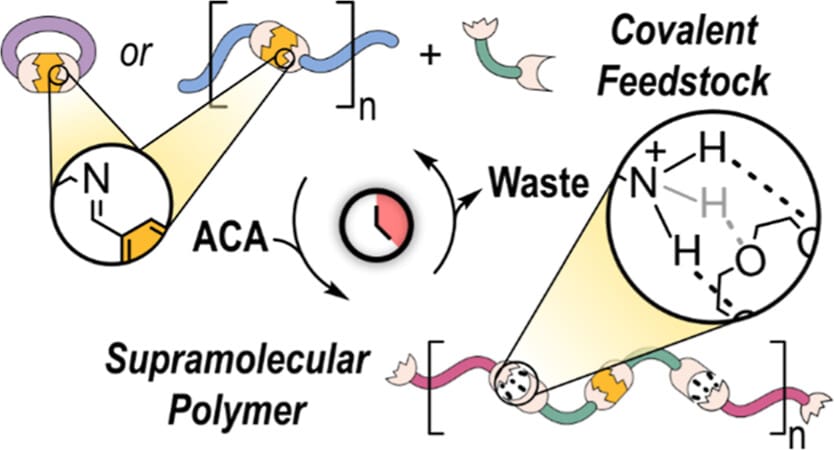Imine-Based Transient Supramolecular Polymers
Systems that change properties upon exposure to chemical stimuli offer the interesting prospect of (partially) mimicking the functions of living systems. Over the past decade, numerous supramolecular systems whose chemical composition and properties are regulated by the dissipation of chemical fuels have been reported. These systems are typically based on the transient transformation of a “dormant” species into an active, self-assembling supramolecular monomer. The process is powered by fuel consumption and terminates upon fuel depletion, restoring the initial dormant state. Previously reported out-of-equilibrium supramolecular polymerizations relied on the activation of the dormant species by adding or removing small structural units to enable supramolecular polymerization. Here, we present an approach that combines the reversibility of dynamic covalent chemistry and supramolecular chemistry to trigger transient supramolecular polymerizations by “recycling” the components of a dynamic combinatorial library (DCL). Treatment of an equilibrated DCL of aliphatic imines and aromatic amines with an activated carboxylic acid (ACA) generates a dissipative dynamic combinatorial library of aromatic imines and protonated aliphatic amines. The transient acidic conditions enable the creation of a supramolecular polymer held together by interactions between the protonated aliphatic amines and the crown ether moieties embedded in the scaffold of the aromatic imines. Thus, fuel dissipation reshuffles the chemical connectivity and enables the temporary transformation of a purely covalent (polymeric) system into a supramolecular polymer. We demonstrate the strategy using two different covalent dormant feedstocks consisting of a diimine macrocycle involving a calix[4]arene scaffold and a distribution of imine (cyclo)oligomers derived from an isophthalaldehyde skeleton.

Melchiorre, G.; Visieri, L.; Valentini, M.; Cacciapaglia, R.; Casnati, A.; Baldini, L.; Berrocal, J. A.; Di Stefano, S.
J. Am. Chem. Soc. 2025
DOI:
doi.org/10.1021/jacs.5c00274
Associated projects:
-
ReHuse
Stimuli-responsive polymers adapt their properties in response to external cues. Engineering such “smart” behavior in artificial systems by molecular design is an exciting fundamental challenge that can lead to technological breakthroughs. Most stimuli-responsive polymers rely on heat and light to trigger changes in materials properties in a predictable fashion. However, limitations intrinsic to these stimuli highlight the necessity of alternative strategies. Naturally evolved systems widely exploit mechanical stimulation to regulate their functions, but recreating such concept in artificial materials has proven extremely challenging thus far.
See more -
ForcING
ForcING is a research project operating within the context of polymer mechanochemistry, a two-decade old research field that studies how mechanical forces propagate at the molecular level within polymeric materials. Key chemical substances for this type of study are mechanophores, species that are sensitive to mechanical forces and produce physicochemical responses as a result of mechanical stimulation. Thus, mechanophores serve the function of force sensors through which we can infer about the mechanical state (and mechanical history) of a material. Despite the tremendous progress obtained in the past two decades, polymer mechanochemistry is still far from having a moleculardetailed knowledge about mechanophores activation.
See more

Let's create a brighter future
Join our team to work with renowned researchers, tackle groundbreaking
projects and contribute to meaningful scientific advancements






















